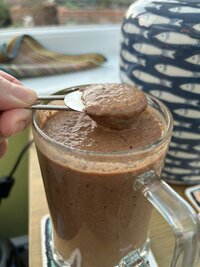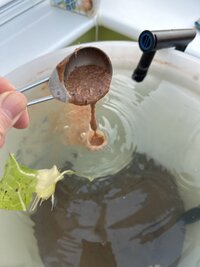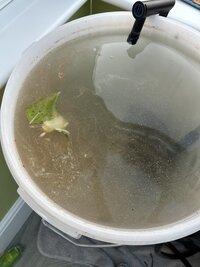I feel quite pleased with myself. I set up the tub of sludge on Saturday 4th February. My hard water in a 30 litre tub and about 6 litres in the Oase Thermo 600. Quite the washing machine
@ExcitableBoy , with a bit of JBL basic plus sand in the bottom. Stock media in the filter is the foam pre-filter and then 2X baskets of plastic x-thingummy-bobs, 2 of medium sponge and a final finer sponge. No ammonia, no nitrites and a trace of Nitrate from the tap water.
Fig 1 : as of today Nitrites giving way to Nitrates
I have tested almost daily and can now see signs there are good germs at work (maybe not the best ones but their in-bred cousins). There is some organic material in the sand but I added a Colliflower leaf, then a raw prawn, then a slice of cucumber and last week, a mussel (sucked clean of white wine sauce beforehand).
Ammonia took some time to arrive but all hell has been let loose once it did, quickly rising to >5m/l but peaked in a few days and is now falling fast, with Nitrites at 5m/l and then Nitrate rising past 50m/l. Textbook stuff. I know that the cheap dipping strips can be very inaccurate, but I'm discounting obvious rouge readings and looking at trends only.
Fig 2: Only a few days ago - rising Ammonia, now falling!
My new tank should be here in a week or two but by then my filter should be at least functioning better. It will take me a week or so faffing before the substrate and hardscape is all in and glued/strapped together. Only then will I transfer the filter to the tank and fill her up. There will be no lights initially, as I am still set on a 'dark start'. A thick cover on the tank while I make sure everything is working - no leaks etc. I have a holiday booked at the end of March, so I may delay the full planting for April. If things go well, I will plant up before I go

I know I am not in charge and am ready to face complete and abject failure (fingers crossed though).
This will be Co2 and heavily planted from day 1 of lights on. Easy plants in the main, with maybe one or three medium ones for a challenge. Any advice here would be most welcome. Fauna will wait until April at the earliest. I hope the 600 will be strong enough to circulate the 900mmx500x500 tank through the little Sera CO2 reactor I bought of the web - mixed reviews on that, but I want to reduce bubbles in the tank if I can. I may use an air stone, timed at night when the lights are off, but all that is another story. I have an Oase skimmer too but that will be on a timer.
I have never experienced fishkeeping with these modern powerful LED lights (In my marine days I used Metal Halide floodlamps and actinic tubes). That will be a steep learning curve too. The two Oase premier units give out what seems a lot of Lumens, but I think they can be turned down in the beginning.
As soon as the tub of sludge settles I will make a little graph to illustrate the comings and goings of the NH3/4, NO2 and No3......
@dw1305 I hope that my deep substrate and gazillions of plants will make my tank 'mature' and stable enough so I can get some Cory's and Oto's in. The tub is just a way to give me a head start, bearing in mind my eternal wait for a tank to turn up


Happy planting guys
Bryan.






